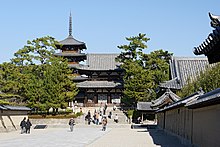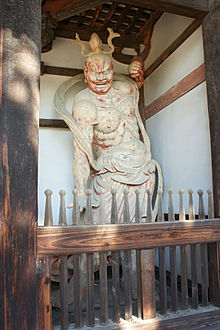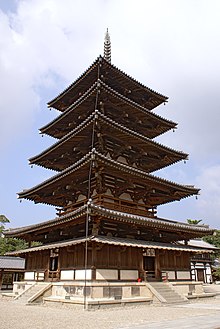Hōryū-ji
The Hōryū-ji ( Japanese. 法 隆 寺 , dt. "Temple of the Buddha's Teaching ") is a Buddhist temple in the city of Ikaruga ( Ikoma district ) in the Japanese prefecture of Nara . He is part of the UNESCO - World Heritage Site , and are located on its premises, the oldest surviving wooden building in the world and also many Japanese national treasures and important national cultural assets .
history
The history of Hōryū-ji begins in the Asuka period around 600 AD, when the sick emperor Yōmei made the vow to build a temple and a statue of Buddha in gratitude for his recovery. He could no longer keep this vow, however, as he died shortly after he had recovered. His wish was fulfilled by his son, the Crown Prince Shōtoku , and the Empress Suiko , who built the temple and the statue in 607 . The temple was called Hōryū-ji or Ikaruga-ji - after its location on the site of the old Ikaruga Palace. Soon after, in 670, a fire raged on the temple grounds, which the Nihonshoki reports that it "spared not a single building." Historians judge this fact as very dubious, as it can be proven that the temple experienced a heyday of great adherence to tradition after its construction over 400 years.
World Heritage
In December 1993, the entire temple district was declared a UNESCO World Heritage Site and placed under monument protection. In the justification of the UNESCO Committee for the Cultural Heritage of Humanity, the arguments can be found that the oldest wooden buildings in the world are still on the site; In addition, the architecture of the buildings shows how the Chinese style slowly influenced architecture in Japan with the advance of Buddhism from China at the time the temple was built in the 7th century.
terrain
The temple district is divided into three parts:
- Saiin Garan ( 西 院 伽藍 ), the Western District
- Tōin Garan ( 東 院 伽藍 ), the Eastern District and the
- Daihōzōin ( 大 宝 蔵 院 ), the gallery of temple treasures
Western district
The western district ( 西 院 伽藍 , saiin garan ) is entered through the southern main gate ( 南 大門 , nandaimon ), which dates from the 14th century. This is the main entrance to the temple. There follows a path that is bordered by walls on the sides and leads to the middle gate ( 中 門 , chūmon ). This gate leads to the cloister ( 回廊 , kairō ), which surrounds the other buildings.
Main hall
The main hall ( 金堂 , kondō , lit. "Golden Hall") was built in the Asuka period (mid-6th to early 8th century). This is where the central sanctuaries to which the temple is dedicated are located, including a Shakyamuni triple group created by the famous sculptor Tori , depicting the historical Buddha and his companions Monju Bosatsu and Fugen Bosatsu . This group of three is flanked by two other statues: to the west by a bronze statue from the Kamakura period depicting a seated Amitabha Nyorai (Buddha of the Pure Land) ; and to the east by a seated Yakushi Nyorai (Buddha of Healing) . These statues are protected by a group of the Four Heavenly Guardians from the Hakuhō period (late 7th to early 8th centuries), which is the oldest group of its kind in Japan. The guardians ( 四 天王 , shitennō ) are carved from camphor wood and stand on defeated evil spirits.
Five story pagoda
This pagoda ( Tō ) was also built in the Asuka period and has a height of 32.45 meters. It is the central sanctuary of the temple and the oldest five-story pagoda in Japan. It is one of the oldest still standing wooden buildings in the world: according to a dendrochronological analysis, the wood of the central column was felled in 594. - Clay statues from the Nara period are exhibited on the ground floor .
Large (lecture) hall
The hall dates from the Heian period (late 8th to late 12th century) and was originally used by monks to study and to hold commemorations. The hall was struck by lightning in 925 and burned down. The current hall was rebuilt in 990.
Inner sanctuary
The inner sanctuary ( 神 の 御堂 , kami no midō ) is said to have been built as early as the 8th century, but historians have been able to prove that it was only built in the Kamakura period in the 12th to 14th centuries. Inside there is another Shakyamuni triad from the Heian period , which is protected by four guards from the Muromachi period .
Western round hall
According to tradition, this actually octagonal hall ( 西 円 堂 , saiendō ) was built by Gyōki Bosatsu in the 8th century. However, research has shown that the current building was built in the Kamakura period . It houses a seated dry varnish statue of Yakushi Nyorai. This figure from the Nara period is the oldest of its kind in Japan.
More buildings
There are also two other buildings in the western district:
- the bell house ( 鐘楼 , shōrō ) and
- the hall of Prince Shōtoku's soul ( shōryōin ), which formerly served as accommodation for the monks. Inside is a statue of Prince Shōtoku.
Eastern district
If you turn east in front of the middle gate and the cloister and follow the path, you come to the main east gate ( 東 大門 , tōdaimon ). This represents the entrance to the Eastern District ( 東 院 伽藍 , tōin garan ). It was built a little later than the Western District, namely only in the 8th century and is on the site of the former Ikaruga Palace , but was only an independent temple with the name Jōgūōin ( Jōgūō Temple , Jōgūō is another name for Prince Shōtoku).
Hall of Visions
Known as the Dream Hall or Hall of Visions ( 夢 殿 , yume dono ), this octagonal pavilion was built in memory of Prince Shōtoku and is the heart of the Eastern District. A life-size statue of Prince Shōtoku is kept here, the so-called Kuse- Kannon from the Asuka period. It is located in a shrine and is therefore in perfect condition to this day. Even the original gilding has been preserved. The statue is surrounded by other statues, such as a statue representing the builder of the Western Ward.
The hall of visions is surrounded by a gallery.
Hall of Buddhist Teachings
This hall ( 電報 堂 , denpōdō ) used to be the residence of Tachibana no Konakachi , the wife of Emperor Shōmus . But when the Eastern District was built, it was converted into a Buddhist hall. An example of old Japanese residential architecture has been preserved.
More buildings
The Eastern District still contains
- the Eastern Bell House ( 東 院 鐘楼 , tōin shōrō ),
- the so-called reliquary hall ( 舎 利 殿 , shariden ), where the relics of the Buddha are kept, who sprang from the palms of the two-year-old prince when he clasped his hands in prayer, and
- the hall of paintings ( 繪 殿 , eden )
The Gallery of Temple Treasures
The buildings in the open space between the Eastern and Western Districts belong to the Gallery of Temple Treasures ( 大 宝 蔵 院 , daihōzōin ). The newest building is the hall of the Kudara- Kannon ( 百 済 観 音 堂 , Kudara-Kannon dō ), which was built in the modern era and completed in 1998. Other important Japanese cultural treasures are exhibited in this hall. Among other things, the most famous Japanese Buddhist statue, the Kudara-Kannon (where Kudara usually referred to the Korean kingdom of Baekje , allied with Japan ) or Avalokitesvara, is exhibited here. It dates from the Asuka period and is famous for its beauty. In the halls of the gallery other finds are also kept that tell the 1400 year old history of Buddhism in Hōryū-ji.
Individual evidence
- ↑ Buddhist Monuments in the Horyu-ji Area - UNESCO World Heritage Center
- ^ Religion in Japan, Temples, Horyuji
- ^ Web Japan, sponsored by the Ministry of Foreign Affairs, Japan .: "One hundred years older than supposed ?: World Heritage Pagoda". Retrieved April 4, 2007 .
Web links
- Official website
- Entry on the UNESCO World Heritage Center website ( English and French ).
- Asian Historical Architecture / Horyuji (many pictures, English)
- Map and description with pictures (German)
Coordinates: 34 ° 36 ′ 52 ″ N , 135 ° 44 ′ 3 ″ E








